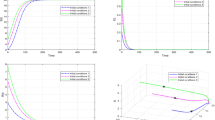Abstract
The periodic behaviors and non-periodic behaviors of recurrent epidemic are discussed by building an SIS model with disease age structure and infectious delay. We formulate the model as an abstract non-densely defined Cauchy problem and derive the conditions for the existence of Hopf bifurcation under the condition where endemic equilibrium is unstable. It implies that the recurrent epidemics will switch between periodic behavior and non-periodic behavior as the parameter values changing when the disease persists in population. The numerical examples are provided to illustrate our theoretical results.









Similar content being viewed by others
References
Begon M, Telfer S, Smith MJ, Burthe S, Paterson S, Lambin X (2009) Seasonal host dynamics drive the timing of recurrent epidemics in a wildlife population. Proc R Soc B 276:1063–1610
Cui J, Sun Y, Zhu H (2008) The impact of media on the control of infectious diseases. J Dyn Differ Equ 20(1):31–53
Engel KJ, Nagel R (2000) One-parameter semigroups for linear evolution equations. Springer, New York
Finkenstadt BF (2002) A stochastic model for extinction and recurrence of epidemics: estimation and inference for measles. Biostatistics 3(4):493–510
Hale JK (1977) Theory of function differential equations. Springer, Heidelberg
Johansen A (1996) A simple model of recurrent epidemics. J Theor Biol 178:45–51
Liu H, Zheng M, Wu D, Wang Z, Liu J, Liu Z (2016) Hysteresis loop of nonperiodic outbreaks of recurrent epidemics. Phys Rev 94:062318. https://doi.org/10.1103/PhysRevE.94.062318
Lloyd AL (2004) Estimating variability in models for recurrent epidemics: assessing the use of moment closure techniques. Theor Popul Biol 65:49–65
Martcheva M, Thieme HR (2003) Progression age enhanced backward bifurcation in an epidemic model with super-infection. J Math Biol 46:385–424
Olinky R, Huppert A, Stone L (2008) Seasonal dynamics and thresholds governing recurrent epidemics. J Math Biol 56:827–839
Pazy A (1983) Semigroups of linear operators and applications to partial differential equations. Springer, New York
Simonsen L (1999) The global impact of influenza on morbidity and mortality. Vaccine 17:S3–S10
Stone L, Olinky R, Huppert A (2007) Seasonal dynamics of recurrent epidemics. Nature 446:533–536
Verdasca J, Telo MM, da Gama A, Numes NR Bernardino, Pacheco JM, Gomes MC (2005) Recurrent epidemics in small world networks. J Theor Biol 233:553–561
Wang L, Zhou D, Liu Z, Xu D, Zhang X (2017) Media alert in an SIS epidemic model with logistic growth. J Biol Dyn 11:120–137
Zheng M, Wang C, Zhou J, Zhao M, Guan S, Zou Y, Liu Z (2015) Non-periodic outbreaks of recurrent epidemics and its network modelling. Sci Rep 5:16010. https://doi.org/10.1038/srep16010
Acknowledgements
We would like to thank the referees very much for the careful review and the valuable comments to this manuscript which improve it greatly. We also should say thanks to professor Jianquan Li, who gave us some helpful suggestions for revising this paper. This work is supported by National Natural Science Foundation of China (Grants 11301314, 11501443, 11671142, and 11371087), by Natural Science Foundation of Shaanxi Provincial Department of Education Grant 18JK0092, and by Natural Science Basic Research Plan in Shaanxi Province of China Grant 2019JM-081.
Author information
Authors and Affiliations
Corresponding author
Additional information
Publisher's Note
Springer Nature remains neutral with regard to jurisdictional claims in published maps and institutional affiliations.
Rights and permissions
About this article
Cite this article
Cao, H., Yan, D., Zhang, S. et al. Analysis of Dynamics of Recurrent Epidemics: Periodic or Non-periodic. Bull Math Biol 81, 4889–4907 (2019). https://doi.org/10.1007/s11538-019-00638-5
Received:
Accepted:
Published:
Issue Date:
DOI: https://doi.org/10.1007/s11538-019-00638-5



